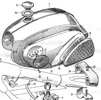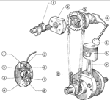|
|
||||
|
||||
Cold Weather Starting
|
Vintage Racers | Motorcycles For Sale | Design | Featured Parts | NOS Parts | Classified Ads |
Things to Keep in Mind:
These bikes (the 250/305 cc family - CB/CA/CL 72/77) are lacking in cold fuel circuitry and have no warm-up idle settings. Hence, you are limited to using the choke and the throttle. However, these are the very same components that you would employ on a cold bike in 90 degree weather.
I won't bore
you with the entire owner's manual recommendation on cold weather starting,
but will, instead, share with you some observations derived from from empirical
testing, AKA trial and error. Below, in normal font, is an account
of my own method (not always successful), followed (in italic font) by
a compilation of Cold Starting Recommendations I received from others.
| Many More Topics: honda305 Discussion Forum | ||
Once it is running, release the throttle and the bike is dead. Start over. If you get it to run again before the battery runs out, try to keep it on high idle (2500 RPM or thereabout) for at least two minutes. These are precarious moments and if you over-rev or under-rev it now, you will flood the plugs, lose the running motor to the elements and will walk the bike back into the garage. Been there, done that.
While the motor is warming up, expect to hear backfires and other indication of its displeasure at the cold. This is normal. Also, don't expect the SuperHawk to perform in an inspiring manner in the first ten minutes of riding. Finally - something that I found to be an interesting peculiarity about these motors - they cool down really fast. On a 50 degree day it will not take long for the bike to cool down enough to feel as if it is not warmed up, even if you only shut it down a half hour ago.
Starting in Cold weather:
- Full Choke, Closed throttle
- I kick start it as not to strain the battery, charging and starter.
- Usually starts in 2-3 kicks.
- I let it run full choke maybe 1/2 a minute, then crack the throttle slowly and open the choke a little.
- If I don't close the choke by then it starts to flood, I hold a 2-3,000 rpm for a minute or 2, open the choke and I'm ready to go.
Here's what works for me.
- Choke all, I mean ALL the way out.
- Throttle - leave it alone.
- Hit start button.
- Hold start button till I hear it start to fire and hold it till it's firing on all 4, then release button.
- Let it idle if it will with the choke all the way out, slowly letting the choke slide in as I begin to work the twist throttle to get it to come to life.
Superhawks
don't like being cold; they work better when they are warmed up. The problems you describe were common when they were new. CV carbs
and accelerator pumps help to eliminate those problems of derivability,
in today's bikes. These components were not installed in old
bikes like Superhawks. They were good bikes, but they have character. Learning to live with its faults is the key to being happy and enjoying
Vintage Japanese Motorcycles.
As you say you set the points 100 miles back, if you had installed new ones at that or near that time I recommend you check them now.
I don't see the larger jets (#45 instead of #42) giving the kind of problem you have. My experience with these engines is that when I have COLD ENGINE WARM UP problems, it has ALWAYS proved to the point timing. This may not be your problem, but is easy to check with a 12 VOLT bulb on a couple of wires.
Your starting woes are typical of the 305s in cold weather. Here's my starting routine:
- If the bike has not been run, I open the petcock and let it sit for a couple of minutes.
- With the choke "on", and ignition "off", I kick the bike over about three times to get some gas in the cylinders.
- Turn on the ignition switch, DO NOT WORK THE THROTTLE.
- With the choke "on", kick (or use starter) to get the bike to start.
- Leave the choke "on" and let the bike run for a several minutes (do not touch the throttle while warming up).
- Close the choke then see if it has warmed sufficiently to accept throttle control.
If the bike seems to be starving for fuel and the problem persists, check these things:
- Be sure you have adequate gas in the tank.
- Be sure that you do not have the petcock on the "reserve" position.
- Be sure the petcock isn't clogged with trash.
- Be sure that the fuel lines aren't "pinched."
I've been reading your repair log and noted the difficulties with starting your 305. Does this machine retain the forward-kicking starter lever? If so, begin using that to start instead of the battery - saving the electric start for places where it is more convenient. Using the electric start pulls down the voltage throughout the entire system - that includes the ignition - right when you need every one of those 12.5 volts at the coil. Using the kick-start, of course, has no deleterious effect on system voltage.
Also, cold-starting on cool or colder days absolutely requires use of the choke. Flip up the choke lever right to the stopping point then back off slightly - the 305 choke in the full-on position completely shuts off the air horn. There is NO spring-loaded relief plate in the middle of the choke plate ala the CB-160, thus the slight backing off after finding the full-on position.
In all these years I've owned and operated my CB77 (26 years) I've only rarely used the electric start, thus allowing the battery to serve well beyond it's 4 or 5 year lifetime. I get a new battery every 6 or 7 years.
How about the carb synchronization? Or air fuel mixture? I don't know anything about the cb77, but my cb750K has been much more willing to start since I had the carbs synched.
| CB-77 | CYP-77 | Road Test | Riding Log | Literature | Zen | Marketplace | VJ Survey | Links | Home |


